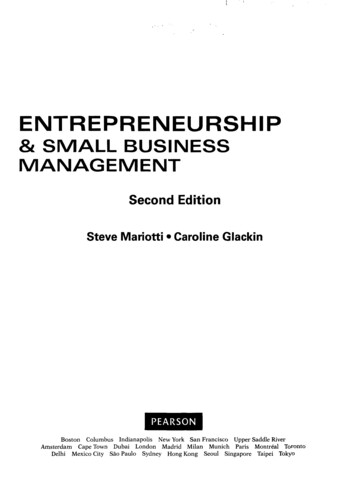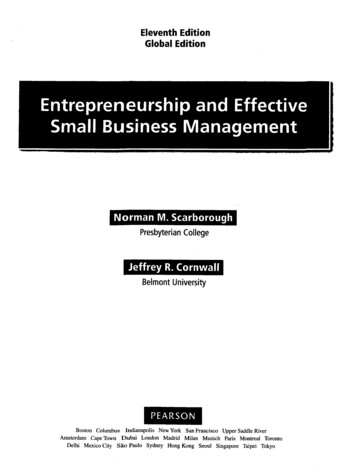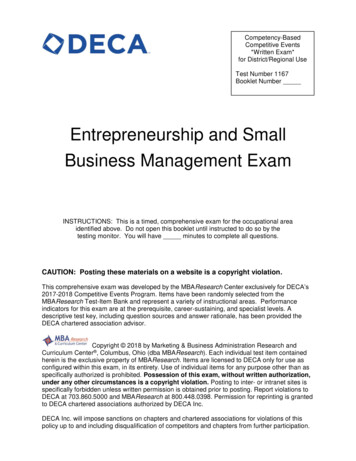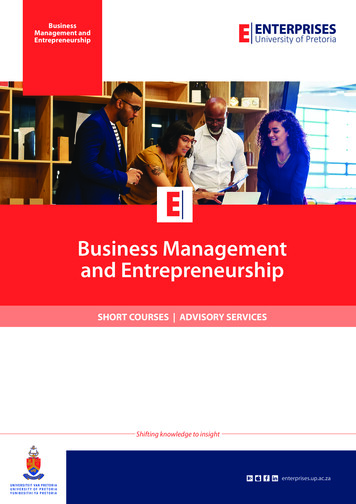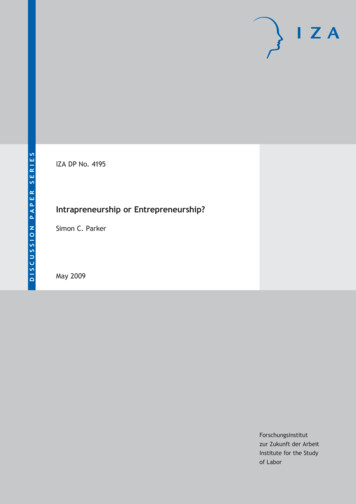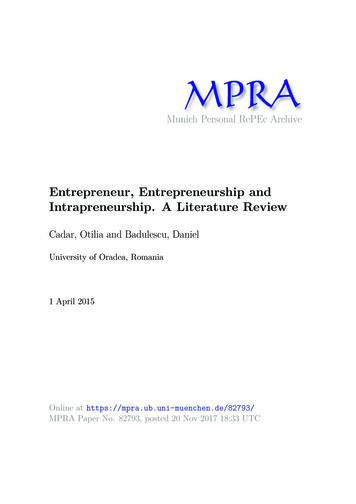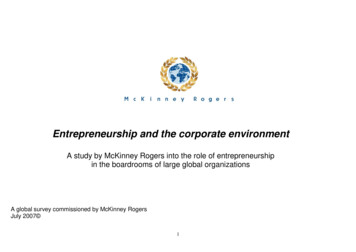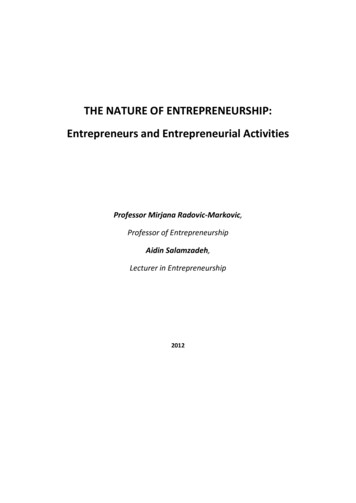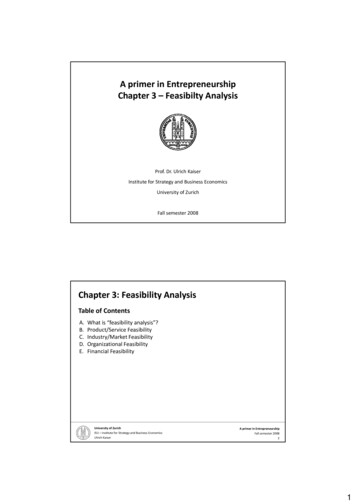
Transcription
A primer in EntrepreneurshipChapter 3 – Feasibilty AnalysisProf. Dr. Ulrich KaiserInstitute for Strategy and Business EconomicsUniversity of ZurichFall semester 2008Chapter 3: Feasibility AnalysisTable of ContentsA.B.C.D.E.What is “feasibility analysis”?Product/Service al FeasibilityFinancial FeasibilityUniversity of ZurichISU – Institute for Strategy and Business EconomicsUlrich KaiserA primer in EntrepreneurshipFall semester 200821
I.Feasibility AnalysisA. What is “feasibility analysis”?1. Feasibility analysis is the process of determining if a business idea isviable.2. It is the preliminary evaluation of a business idea, conducted for thepurpose of determining whether the idea is worth pursuing.3. Feasibility analysis takes the guesswork (to a certain degree) out of abusiness launch, and provides an entrepreneur with a more securenotion that a business idea is feasible or viable.University of ZurichISU – Institute for Strategy and Business EconomicsUlrich KaiserI.A primer in EntrepreneurshipFall semester 20083Feasibility AnalysisA. What is “feasibility analysis”?Timing of feasibility analysis:It follows the opportunity recognition stage and comes before thedevelopment of a business plan Î see next figureUniversity of ZurichISU – Institute for Strategy and Business EconomicsUlrich KaiserA primer in EntrepreneurshipFall semester 200842
I.Feasibility AnalysisA. What is “feasibility analysis”?University of ZurichISU – Institute for Strategy and Business EconomicsUlrich KaiserI.A primer in EntrepreneurshipFall semester 20085Feasibility AnalysisA. What is “feasibility analysis”?a.b.c.Although the sequence pictured makes perfect sense, statistics showthat the majority of entrepreneurs do not follow this pattern beforelaunching their ventures.Several studies have investigated why this is the case. The consensusof the research is that entrepreneurs tend to underestimate theamount of competition there will be in the marketplace and tend tooverestimate their personal chances for success.Before a company undertakes a feasibility analysis, a conceptstatement should be developed.University of ZurichISU – Institute for Strategy and Business EconomicsUlrich KaiserA primer in EntrepreneurshipFall semester 200863
I.Feasibility AnalysisA. What is “feasibility analysis”?Four forms of feasibility analysisProduct/Service FeasibilityAnalysisIndustry/Market FeasibilityAnalysisOrganizational FeasibilityAnalysisFinancial FeasibilityAnalysisUniversity of ZurichISU – Institute for Strategy and Business EconomicsUlrich KaiserA primer in EntrepreneurshipFall semester 20087Chapter 3: Feasibility AnalysisTable of ContentsA.B.C.D.E.What is “feasibility analysis”?Product/Service al FeasibilityFinancial FeasibilityUniversity of ZurichISU – Institute for Strategy and Business EconomicsUlrich KaiserA primer in EntrepreneurshipFall semester 200884
I.Feasibility AnalysisB. Product/Service Feasibilitya.b.c.Is an assessment of the overall appeal of the product or service beingproposed.The idea is that before a pprospectivepfirm rushes a productpor service intodevelopment, it should be confident that the product or service is what itsprospective customers want.The two components of a product/service feasibility analysis are:i.Concept testingii.Usability testingUniversity of ZurichISU – Institute for Strategy and Business EconomicsUlrich KaiserI.A primer in EntrepreneurshipFall semester 20089Feasibility AnalysisB. Product/Service Feasibility1.2.Concept testingUsability testingUniversity of ZurichISU – Institute for Strategy and Business EconomicsUlrich KaiserA primer in EntrepreneurshipFall semester 2008105
I.Feasibility AnalysisB. Product/Service Feasibility1. Concept Testinga. A concept test entails showing a representation of the product orservice to pprospectivepusers to ggaugeg customer interest,,desirability, and purchase intent.b. A concept statement is a one page description of a business that isdistributed by a startup entrepreneur to people who are asked toprovide feedback on the potential of the business idea.c. There are three primary purposes for a concept test:i.to evaluate the underlying premises of a product or servicethat an entrepreneur thinks is compellingii. to help develop an ideaiii. to estimate the potential market share the product or servicemight command.University of ZurichISU – Institute for Strategy and Business EconomicsUlrich KaiserI.A primer in EntrepreneurshipFall semester 200811Feasibility AnalysisB. Product/Service Feasibility1. Concept testingInformation to Includea. A description of the product or service being offered.b. The intended target market.c. The benefits of the product or service.d. A description of how the product will be positioned relative tosimilar ones in the market.e. A descriptionpof how the pproduct or service will be sold anddistributed.f. Information about the founder or founders of the firm.University of ZurichISU – Institute for Strategy and Business EconomicsUlrich KaiserA primer in EntrepreneurshipFall semester 2008126
University of ZurichISU – Institute for Strategy and Business EconomicsUlrich KaiserI.A primer in EntrepreneurshipFall semester 200813Feasibility AnalysisB. Product/Service Feasibility1.2.Concept testingUsability testingUniversity of ZurichISU – Institute for Strategy and Business EconomicsUlrich KaiserA primer in EntrepreneurshipFall semester 2008147
I.Feasibility AnalysisB. Product/Service Feasibility2. Usability TestingA concept test is usually followed by the development of a prototype ormodel of the product or service.University of ZurichISU – Institute for Strategy and Business EconomicsUlrich KaiserI.A primer in EntrepreneurshipFall semester 200815Feasibility AnalysisB. Product/Service Feasibility2. Usability Testinga. Is the method by which users of a product are asked to performcertain tasks in order to measure the product’s ease‐of‐use and theuser’s perception of the experience.b. Usability tests are sometimes called user tests, beta tests, or fieldtrials, depending on the circumstances involved.c. While it is tempting to rush a new product or service to market,conducting a usability test is a good investment of anentrepreneur’s or firm’s resources.d. Many products that consumers find frustrating to work with havebeen brought to market too quickly.University of ZurichISU – Institute for Strategy and Business EconomicsUlrich KaiserA primer in EntrepreneurshipFall semester 2008168
I.Feasibility AnalysisB. Product/Service Feasibility2. Usability Testinga. Prototypei.Conducting a usability test typically requires the developmentof a prototype.ii. A prototype is the first physical depiction of a new product,which is usually still in a rough or tentative mode.b. Virtual Prototype: a virtual prototype is a computer‐generated 3Dimage of an idea. It displays an invention as a 3D model that can beviewed from all sides and rotated 360 degrees.For products, like a new board game, a prototype is needed to getmore substantive feedback than can be gleaned from a conceptstatementUniversity of ZurichISU – Institute for Strategy and Business EconomicsUlrich KaiserA primer in EntrepreneurshipFall semester 200817Role of feasibility analysis in the development of successfulbusiness ideas at Activision (an electronic games company)The Activision “Green Light Process”University of ZurichISU – Institute for Strategy and Business EconomicsUlrich KaiserA primer in EntrepreneurshipFall semester 2008189
I.Feasibility AnalysisB. Industry/Market Feasibilitya.b.Is an assessment of the overall appeal of the market for the product orservice being proposed.For industry/market feasibility analysis, there are three primary issuesthat a proposed business should consider:i.industry attractivenessii. market timelinessiii.identification of a niche market.University of ZurichISU – Institute for Strategy and Business EconomicsUlrich KaiserI.A primer in EntrepreneurshipFall semester 200819Feasibility AnalysisB. Industry/Market Feasibilityi.Industry AttractivenessA primary determinant of a new venture’s feasibility is the attractiveness ofthe industry it chooses.University of ZurichISU – Institute for Strategy and Business EconomicsUlrich KaiserA primer in EntrepreneurshipFall semester 20082010
I.Feasibility AnalysisB. Industry/Market Feasibilityi.I.II.Industry AttractivenessIndustries vary considerably in terms of their growth rateIn general, the most attractive industries are characterized as thefollowing:(1) Are large and growing;(2) Are important to the customer;(3) Are fairly young rather than older and more mature;(4) Have high, rather than low, operating margins;(5)Are not crowded.University of ZurichISU – Institute for Strategy and Business EconomicsUlrich KaiserI.A primer in EntrepreneurshipFall semester 200821Feasibility AnalysisB. Industry/Market Feasibilityi.Industry Attractiveness(1) AlthAlthoughh ththe criteriait i shownhon ththe precedingdi slidelid iis an idideall lilist,t ththe extentt tto which a new business’s proposed industry’s growth possibilities satisfythese criteria should be taken seriously.(2) In addition to evaluating an industry’s growth potential, a new venture willwant to know more about the industry it plans to enter.(3) This can be accomplished through both primary and secondary researchUniversity of ZurichISU – Institute for Strategy and Business EconomicsUlrich KaiserA primer in EntrepreneurshipFall semester 20082211
I.Feasibility AnalysisB. Industry/Market FeasibilityRole of Primary and Secondary Research in Investigating IndustryAttractivenessType of ResearchPrimary researchSecondaryresearchHow It Is ConductedThis is research that is original and is collected by theentrepreneur. In assessing the attractiveness of a newmarket, this typically involves an entrepreneur talking topotential customers and key industry participants.This is research that probes data that are already collected.collectedExamples of where this data might come from are: industry‐related publications, government statistics, competitor’s Websites, and industry reports from research firms like ForresterResearch.University of ZurichISU – Institute for Strategy and Business EconomicsUlrich KaiserI.A primer in EntrepreneurshipFall semester 200823Feasibility AnalysisB. Industry/Market FeasibilityMarket timeliness considerationsNature of Product orService IntroductionMajor ConsiderationsImprovement onsomething alreadyavailable in themarketplace Is the window of opportunity open or closed? Is now a good time for a new market entrant (i.e.,are customers buying, are industry incumbentsmaking money?)Breakthrough newproduct or service, whichshould establish a newmarket segment Should we try to capture a first‐mover advantage?University of ZurichISU – Institute for Strategy and Business EconomicsUlrich KaiserA primer in EntrepreneurshipFall semester 20082412
I.Feasibility AnalysisB. Industry/Market Feasibility3. Identification of a Niche Marketa. A niche market is a place within a larger market segment thatrepresents a narrower group of customers with similar interestsinterests.b. For a new firm, selling to a niche market makes sense for at least tworeasons:i.It allows a firm to establish itself within an industry withoutcompeting against major competitors head on.ii. A niche strategy allows a firm to focus on serving a specializedmarket very well instead of trying to be everything to everybodyin a broadb oad market,a et, whichc iss nearlyea y impossibleposs b e foro a newe eentrant.ta tUniversity of ZurichISU – Institute for Strategy and Business EconomicsUlrich KaiserI.A primer in EntrepreneurshipFall semester 200825Feasibility AnalysisB. Industry/Market Feasibility3. Identification of a Niche MarketAnother useful way of thinking about this topic is to distinguishbetween vertical and horizontal markets.:markets :a. A vertical market, which is analogous to a niche market, focuses onsimilar businesses that have specific needs. Start‐ups typically startby selling into vertical markets.b. A horizontal market meets the specific needs of a wide variety ofindustries, rather than a specific one.University of ZurichISU – Institute for Strategy and Business EconomicsUlrich KaiserA primer in EntrepreneurshipFall semester 20082613
Chapter 3: Feasibility AnalysisTable of ContentsA.B.C.D.E.What is “feasibility analysis”?Product/Service al FeasibilityFinancial FeasibilityUniversity of ZurichISU – Institute for Strategy and Business EconomicsUlrich KaiserI.A primer in EntrepreneurshipFall semester 200827Feasibility AnalysisC. Organizational Feasibility AnalysisIs concerned with determining whether the business itself has sufficient skillsand resources to bring a particular product or service idea to marketsuccessfullysuccessfully.a. management expertiseb. organizational competencec. resourcesd. There are two primary issues to consider in this area:i.Management prowessiiii.Resource sufficiencyUniversity of ZurichISU – Institute for Strategy and Business EconomicsUlrich KaiserA primer in EntrepreneurshipFall semester 20082814
I.Feasibility AnalysisC. Organizational Feasibility1. Management Prowessa. A firm should candidly evaluate the prowess (ability) of its managementteam to make sure management has thei.requisite passion andii. expertise to launch the venture.b. The most important factors in this area are:i.The passion that the solo entrepreneur or the founding team has forthe business idea.iiii.The extent to which the solo entrepreneur or the founding teamunderstands the markets in which the firm will participate.c. Solo entrepreneurs or founding teams with established social andprofessional networks also have an advantage.University of ZurichISU – Institute for Strategy and Business EconomicsUlrich KaiserI.A primer in Entreprene
C. Organizational Feasibility Analysis I. Feasibility Analysis. a. management expertise b. organizational competence c. resources d. There are two primary issues to consider in this area: i. Management prowess ii Resource sufficiency University of Zurich ISU –Institute for Strategy and Business Economics Ulrich 28Kaiser
